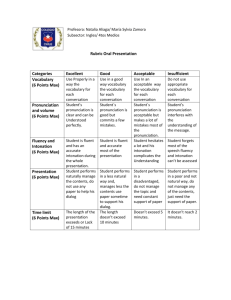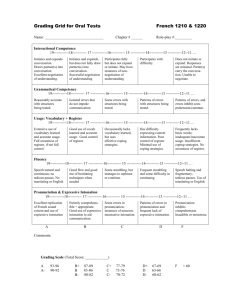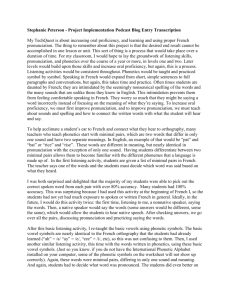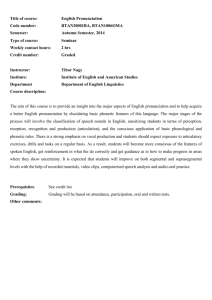Syllabus for Practical British English Phonetics
advertisement
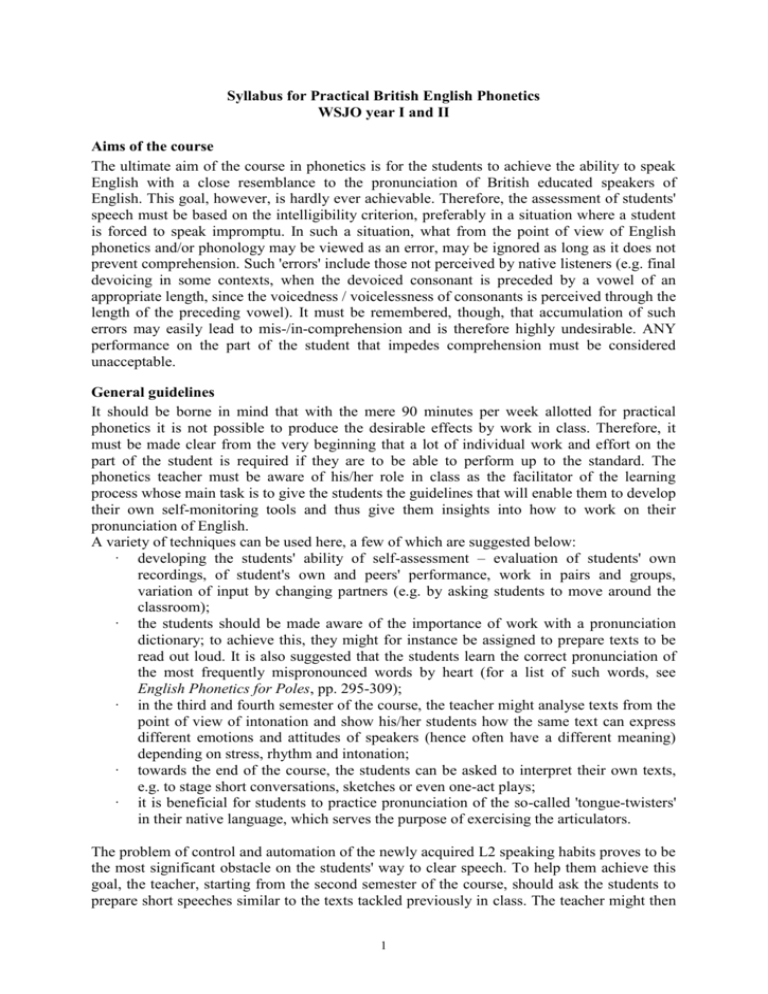
Syllabus for Practical British English Phonetics WSJO year I and II Aims of the course The ultimate aim of the course in phonetics is for the students to achieve the ability to speak English with a close resemblance to the pronunciation of British educated speakers of English. This goal, however, is hardly ever achievable. Therefore, the assessment of students' speech must be based on the intelligibility criterion, preferably in a situation where a student is forced to speak impromptu. In such a situation, what from the point of view of English phonetics and/or phonology may be viewed as an error, may be ignored as long as it does not prevent comprehension. Such 'errors' include those not perceived by native listeners (e.g. final devoicing in some contexts, when the devoiced consonant is preceded by a vowel of an appropriate length, since the voicedness / voicelessness of consonants is perceived through the length of the preceding vowel). It must be remembered, though, that accumulation of such errors may easily lead to mis-/in-comprehension and is therefore highly undesirable. ANY performance on the part of the student that impedes comprehension must be considered unacceptable. General guidelines It should be borne in mind that with the mere 90 minutes per week allotted for practical phonetics it is not possible to produce the desirable effects by work in class. Therefore, it must be made clear from the very beginning that a lot of individual work and effort on the part of the student is required if they are to be able to perform up to the standard. The phonetics teacher must be aware of his/her role in class as the facilitator of the learning process whose main task is to give the students the guidelines that will enable them to develop their own self-monitoring tools and thus give them insights into how to work on their pronunciation of English. A variety of techniques can be used here, a few of which are suggested below: · developing the students' ability of self-assessment – evaluation of students' own recordings, of student's own and peers' performance, work in pairs and groups, variation of input by changing partners (e.g. by asking students to move around the classroom); · the students should be made aware of the importance of work with a pronunciation dictionary; to achieve this, they might for instance be assigned to prepare texts to be read out loud. It is also suggested that the students learn the correct pronunciation of the most frequently mispronounced words by heart (for a list of such words, see English Phonetics for Poles, pp. 295-309); · in the third and fourth semester of the course, the teacher might analyse texts from the point of view of intonation and show his/her students how the same text can express different emotions and attitudes of speakers (hence often have a different meaning) depending on stress, rhythm and intonation; · towards the end of the course, the students can be asked to interpret their own texts, e.g. to stage short conversations, sketches or even one-act plays; · it is beneficial for students to practice pronunciation of the so-called 'tongue-twisters' in their native language, which serves the purpose of exercising the articulators. The problem of control and automation of the newly acquired L2 speaking habits proves to be the most significant obstacle on the students' way to clear speech. To help them achieve this goal, the teacher, starting from the second semester of the course, should ask the students to prepare short speeches similar to the texts tackled previously in class. The teacher might then 1 ask her/his students to prepare their own weather forecasts / guided tour commentaries / news items / stories about school experiences / descriptions of dreams etc. Focus and problem areas Though the major focus of instruction in the first two semesters of the course is the acquisition of the ability to produce the English segmentals, language being a closed system, it is impossible to separate suprasegmental features from spoken language. Therefore phonetics teachers are advised and encouraged to provide their students with as many insights into aspects of stress, rhythm, intonation and connected speech as possible from the very beginning of the course. An appropriate balance between theoretical instruction and practice must of course be kept and, needless to say, the more complicated a phonological problem, the later in the course it should be mentioned. The following phonological processes ought to be explained during the course: · the general notion of interference (transfer) from L1; · palatalisation, with the emphasis on the Polish allophone [?] (e.g. cf. PL 'nit' vs. ENG 'need'; · devoicing (cf. the example above); · nasalisation (e.g. ENG 'chance', 'prince' vs. PL 'szansa', 'tramwaj'); · the fact that /?/ exists in Polish as an allophone of /n/ and according to the Polish rules of phonetic distribution occurs only followed either by / k/ (e.g. 'parking', 'bank') or /g/ (e.g. 'kangur', 'Kongo'); it must be noted that the distribution of /?/ among some speakers of Polish can be very limited, while relatively frequent among other; · aspiration of syllable-initial voiceless stops; · the problem of stress, content words and the resultant vowel reduction, the distribution of /?/; · differences between British and American English, including those on the systematic (phonetic inventory), allophonic (dark vs. clear 'l') and connected speech (r-colouring for American English) level. The third semester should be devoted to the consolidation of segmentals. In the fourth semester of the course the emphasis is on the suprasegmental features, especially the so-called fast speech processes: linking, elision, glottaling, insertion, assimilation and coalescence. Time allowing, teachers might introduce elements of intonation. It must be made clear to the students that the acquisition of intonation patterns and their appropriate use is a process completely different from the work on the acquisition of segmentals. Since intonation is context-bound and relative (it is up to a speaker to choose an intonation pattern depending on what s/he wants to express), it is only through a vast amount of language exposure that the students can acquire what can be termed the desired intonation habits. Thus the teacher's role in the fourth semester is in a sense even more limited to merely providing the students with the necessary guidelines for their own study along with as much varied language material as possible. Prepared by Maciej Machniewski 2 The course in British English Practical Phonetics will be run over four semesters: Semester 1 Scope of instruction: British vowels: pure vowels, diphthongal glides, diphthongs. Each sound will be practised individually and in opposition to other sounds (e.g. long against short monophthongs, monophthongs against diphthongs). Particular attention should be paid to the durational aspect of vowels (opposition between long and short vowels). Students should be made aware of the differences between Polish and BrEnglish vowels. Crucial issues should be pointed out by the teacher (e.g. pre-fortis clipping, strong and weak vowels, etc.) Teaching materials: Say it right Sawala, Szczegóła, Weckwerth (main coursebook), (students are obliged to buy a copy) Additional materials: “Sounds English” J.D. O’Connor & C. Fletcher, “Practice in spoken English”, G.L. Barnard & P.S. McKay. Classroom practice: work with books and tapes/CDs, drills, individual and pair work. Students may be asked to read out loud short text from the book and to prepare short speeches to be delivered in front of the group. Assessment: continuous assessment on the basis of students’ in-class performance (homework, exercises from the book, speeches, etc.), texts recorded at home, and their performance during individual meetings that will be held at regular intervals throughout the semester. Peer assessment and correction should be encouraged. Semester 2 Scope of instruction: consonants - obstruents and sonorants. Each consonant will be practised individually and in opposition to other sounds (e.g. voiced against voiceless consonants). Particular attention should be paid to crucial aspects (e.g. aspiration, linking and intrusive “r”, final devoicing, “-ing” endings) Teaching materials: Say it right Sawala, Szczegóła, Weckwerth (main coursebook), Additional materials: “Sounds English” J.D. O’Connor & C. Fletcher, “Practice in spoken English”, G.L. Barnard & P.S. McKay, “Phonetic Drills” J.D. O’Connor. Classroom practice: work with books and tapes/CDs, drills, individual and pair work. Tongue twisters and pronunciation games can be used as warm-up exercises. Students may be asked to deliver short impromptu speeches (e.g. on the topics discussed in communication classes). Students may also practice reading from the phonetic transcript (see “Phonetic Drills” J.D. O’Connor). Assessment: see above. 3 Semester 3 Scope of instruction: Revision of vowels and consonants. Semester 3 will be devoted to the revision of the material covered during the first two semesters, with particular emphasis put upon the most difficult sounds with which students may still have problems. Issues also tackled in the semester shall include: primary and secondary stress, stress shift and rhythm. Due amount of time and attention should also be devoted to practising weak forms and linking. Teaching materials: texts from “Sounds English”, “Modern English Pronunciation Practice” and “Phonetic Drills” may be used for revising vowels and consonants. Short exercises for stress and linking can be found in “Sounds English”, “Phonetic Drills”, “Rhymes and Rhythm”. Classroom practice: work with books and tapes/CDs, texts read out loud, impromptu speeches delivered in front of the group. Students may also be asked to stage short mini roleplays. Assessment: see above Semester 4 Scope of instruction: Focus on the phonotactic processes that might only briefly have been mentioned in the previous semesters, i.e.: linking, elision, glottaling, insertion, assimilation and coalescence. Time allowing, British English intonation. Students will practise the most common intonation patterns of British English (i.e. fall, rise, fall-rise, rise-fall) and be made aware of different functions of intonation. Teaching materials: “Rhymes and Rhythm”, “Here is the News”. Apart from these, the teacher may also present recordings of BBC news, interviews, episodes of British sit-coms as means of providing students with some exposure to genuine British speech. “Intonation in Context” by B. Bradford and “Pronunciation for Advanced Learners of English” by D. Brazil. Classroom practice: work with books and tapes/CDs, impromptu speeches delivered in front of the group. Students may also be asked to stage short mini role-plays. Assessment: see above 4 Course books and reference materials: Sawala, Szczegóła, Weckwerth Baker, A. Barnard G.L., P.S. McKay Bradford, B. Brazil, D. 2011 Cruttenden, A. 1994 Hancock, M. Fisiak, J., M. LipińskaGrzegorek, T. Zabrocki Mortimer, C. 2003 1978 Munro Mackenzie, M.D. 1967 O’ Connor J.D., C. Fletcher O’Connor, J.D. O’Connor, J.D. Phonsoby, M. Sobkowiak, W. Voughan-Rees, M. Wells, J.C. 1989 1980 1963 1988 1994 1993 1996 1992 1990 Say it right Ship or Sheep? CUP Practice in Spoken English. London: MacMillan Intonation in Context. CUP Pronunciation for Advanced Learners of English. CUP Gimson’s Pronunciation of English. London: Edward Arnold English Pronunciation in Use. CUP An Introductory Polish-English Contrastive Grammar. Warszawa: PWN Dramatic Monologues for Listening Comprehension. CUP Modern English Pronunciation Practice. London: Longman Sounds English. Essex: Longman Better English Pronunciation. CUP. Phonetic Drills How now, brown cow. Prentice Hall English Phonetics for Poles. Poznañ: Bene Nati Rhymes and Rhythm. Longman Pronunciation Dictionary. Essex: Longman 5



